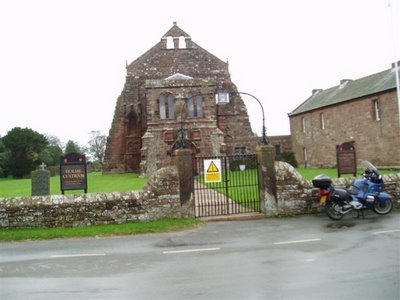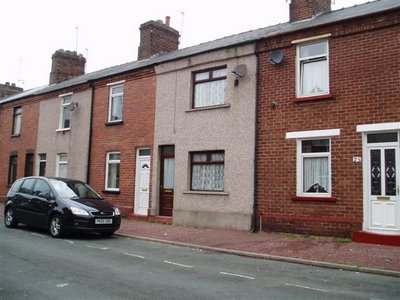So what was Belgium like? I hear you ask rather belatedly. I'm glad you asked, so I'll tell you. It was bloody hot for a start! And it was rather a struggle on the crutches, of which more anon, but it was a very enjoyable weekend.
No problems on the outward bound flight on Friday, and rather annoyingly no one took the trouble to open the envelope and read the medical certificate which I had been forced to piss about getting. Still, I had it with me just in case.
So we got there uneventfully and we (my dad and me) were collected by my brother at Charleroi, having waited for about an hour in unventilated, un-airconditioned, sweltering heat for our bags to be offloaded and appear on the carousel. Tempers were running a bit high amongst some of our fellow passengers, and it turned out that the baggage handlers (amongst others) were on strike at Brussels airport which meant that Charleroi was not only busier than usual but was subject to the handlers there apparently being arsy in support of their colleagues.

So once we got into the car we decided there was no point in wasting time going to the hotel, so we headed towards Brussels, stopping enroute at the battle of Waterloo memorial. Very little mention of Wellington, but lots of Napoleon and they clearly were unaware that the short arse had lost the battle! The photo on the right is of Napoleon and the way he is depicted standing with his arms folded he looks like he's having a bit of a hissy fit. You can't actually see a petted lip, but I think it's there!
After a brief stop at Waterloo we carried on to Brussels, and found ourselves near the Grand Place eating lovely sandwiches on hot bread.

A bit of a wander round and we saw the famous pissing boy, sorry, Mannequin Pis, which frankly isn't worth crossing the street to look at, never mind travelling to Belgium. What was worth looking at though was the beer shop nearby which has an unfortunate name. I'm sure they don't actually sell Piss Beer!
Brussels is full of cobblestones. Said cobbles are rather uneven with big gaps between lots of them. I am on crutches. Crutches have rubber bits on the end to stop them slipping. If you put a crutch into one of the gaps between cobbles often enough then the metal pole which is the actual crutch eventually will pierce the rubber stopper on the end and poke through. If you then use the crutch on stone or tiled surfaces it
will slide. This isn't hypothetical. Day one and one of the crutches was knackered, causing me for the rest of the weekend to be very careful where I put the crutch, careful not to angle it out too much (keeping it as vertical as possible) and careful not to go too fast or too far for too long. It was
much harder work than it would have been with undamaged crutches. When I got back home I went to the fracture clinic and they changed the ends in about 30 seconds. What a difference!
Anyway, Brussels was a nice city, the little we saw of it (see reason above) but very busy.
On Friday evening we had dinner in the hotel in Charleroi. It was acceptable but unexceptional, although it was nice to be able to eat outside in the still-warm weather.
On Saturday we decided we'd head to Ypres and have a look at a war cemetery as well as the city itself. The cemetery we chose was
Tyne Cot, which is the largest of them with a

round 12,000 soldiers of the Commonwealth Forces buried there. About 70% (that's over 8,000) graves have no names on the headstones but are marked simply "Known unto God" and the wall at the rear of the cemetery lists 35,000 names of soldiers who died but have no known grave. These are numbers. The numbers are staggering. But more staggering are the rows and rows of identical white Portland stone headstones.
A lot of men died near Ypres. You may have heard of the battle, no, slaughter, at Passchendaele. That was just one of the battles at the Ypres salient between October 1914 and

October 1918.
In Flanders Fields, by John McCrae
In Flanders fields the poppies blow
between the crosses, row on row
that mark our place; and in the sky
the larks, still bravely singing, fly
scarce heard amid the guns below.
We are the Dead. Short days ago we lived, felt dawn, saw sunset glow.Loved and were loved, and now we lie
we lived, felt dawn, saw sunset glow.Loved and were loved, and now we lie
in Flanders fields.
Take up your quarrel with the foe:
To you from failing hands we throw
the torch; be yours to hold it high.
If ye break faith with us who die
we shall not sleep,
though poppies growin Flanders fieldsAnyway, that was Tyne Cot. A very moving place.
We then tried to look at Ypres, but there was a market on in the town centre and we couldn't find a parking place close enough for me to hobble so we cut our losses and headed north to Bruges.
Bruges is a lovely city and undoubtedly was the high spot of the weekend (Belgium-wise that is, it goes without saying that it was great to see my brother and to spend time with him and dad).

We found some underground parking near the centre and wandered to the square, which might be called the Grand Place, or might not. Lovely architecture and some great looking cafe-bars around the edge. Selecting one more or less at random (see photo left) we sat outside, shaded from the warm sunshine, and had some cold beers and a set lunch. Flanders stew is delicious and I heartily recommend it. Except if you're a vegetarian of course.
After lunch we took a stroll round, finding another square and what looked like a mediaeval church which on inspection inside seemed to related to the crusades.
A busy town, but not as busy as Brussels had felt. I will certainly go back and visit Bruges once my mobility is unimpaired. I quite fancy taking the bike across on the Rosyth - Zebrugge ferry and doing it that way. Of course I'd also have a further look a bit around Belgium generally, but Bruges was excellent and I could easily and happily spend some time there.
On Saturday evening we ate in Charleroi, but not in the hotel this time. We started by heading off to, of all things, an Irish bar! There is clearly a European law which requires all towns to have one, because we saw one just about everywhere. The
Irish Times Pub in downtown Charleroi was everything you'd expect. And I don't really mean that as much of a compliment. It was OK, but very smoky for one thing. Drinking in Scotland where there is a ban on smoking indoors (and in Ireland too for that matter) you forget how spoilt you become by the luxury of being able to breathe clean air and go home at the end of the night not smelling like an ashtray. The selection of Belgian beers in the pub was poor, but then again if you're looking for Belgian beers in Belgium you just have to go anywhere else rather than an Irish bar so you can't really complain. Big screen TV showing Manchester United playing against someone else. And probably Watney's Red Barrel and Fish & Chips. The Guinness was OK.
We then ate in
Cafe Leffe, which was perfectly fine. They wouldn't let us sit outside at the pavement tables which seemed to be reserved for those drinking but not eating. After some hilarity (!) with the waiter and discussion on how to pronounce the word Archiduke (don't ask) my brother and I both ordered Filet de Beouf and dad ordered chicken of some description. When the plates were delivered my beouf looked remarkably light coloured, even under the Rocquefort sauce, in comparison with the other one (which was supposed to be identical apart from having Archiduke sauce on it. When I scraped the sauce away I discovered that my beouf looked remarkably like pork. I really couldn't be arsed trying to sort it out so just ate it anyway. I could understand if I was the only one ordering it, but we actually ordered two of the same dish cooked the same way (apart from the sauce) at the same time. Not to worry. The pork was fine. As apparently were the beef and chicken.

Back then to the hotel for some more beer (see right) and lazing about outside enjoying the weather.
Next morning we went back to the airport and flew back to Glasgow Prestwick airport (No! Stop calling it that Ryanair. It isn't in Glasgow).
As I climbed the steps to the aircraft the senior cabin crew person (German - wonderful sense of humour, the Germans) tried to give me grief for not having requested assistance in advance. I told her I didn't need assistance. She said I did. I said I hadn't had any problems on the flight out and in fact when I had called Ryanair in advance they told me I wouldn't need assistance as long as I could get about on crutches. She told me I should have asked again. Wait a minute, so she was suggesting that once I have asked a question and received a reply, I should continue asking the same question until I received a different reply. Fanny. She made a big show of having to ask people to move seat to accommodate me. Fanny. Everyone else was fine (her colleagues were kind of rolling their eyes in her direction as I hobbled up the aisle, as if in apology for their fanny of a colleague). She'd obviously had a bad day but I wasn't going to let her bad attitude spoil my mood. Let her screw up her own blood pressure if she wants.
Anyway, all in all a good weekend. I haven't mentioned the obvious thing about Belgium (OK, one of the obvious things, but the most obvious to me) the beer. We had plenty and it was good lager. Sod all that fruity flavoured nonsense. If I want to taste fruit I'll drink Ribena. The bog standard lager was perfectly adequate, and thankfully ubiquitous.
So, Belgium - go there, especially Bruges.
 They shall not grow old, as we that are left grow old:
They shall not grow old, as we that are left grow old:























